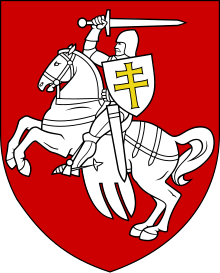Pahonja (heraldry)

The Pahonja ( Belarus. Пагоня, Polish Pogoń , Pogonia ) is a coat of arms motif of Belarus in a historical coat of arms of particular political importance. The term can be translated as “persecution”.
It shows in red an attacking white sword-wielding knight on a silver horse, leading a silver shield that shows a gold cross with two crossbars.
history
Horses and riders were popular even on seals. Heraldically , the coat of arms is counted in the group of riders with sword. Since the 14th century it has been almost identical to the Lithuanian coat of arms of the Grand Duchy , which can be explained by the same roots. The double cross was already adopted from Byzantium by the Europeans in the 7th century and in Rus it was spread from the 12th century. It is one of the older coats of arms in Europe. The cross shape, the same and different cross arms, shaped the appearance over time. The patriarchal cross was the exit. Except for small details, it resembled the Hungarian double cross in the royal coat of arms of the Anjou dynasty and later found its way into the coat of arms of Naples (Kingdom) and Lorraine through the marriage of the Princes of Anjou.
The coat of arms symbol can be dated to around 1366, as it was depicted on the arms of the Grand Duke Algirdas .
When the tsarist empire collapsed in 1917, the Belarusian People's Republic was established in Minsk , but it only existed for eight months and wore the rider and the flag in white, red and white.
The nationalists who collaborated with the German occupiers during the Second World War also used this symbol, which can be recognized by the seal of the Beloruthenian Central Council .
In 1991 the Supreme Belarusian Soviet reintroduced the pahonja symbol as the national coat of arms. In 1995, following a controversial referendum, a new state flag and coat of arms were introduced at the suggestion of President Aljaksandr Lukashenka . Since then, the pahonja and the white, red and white flag have become symbols of the opposition.
In the Lithuanian national coat of arms (the symbol was adopted under the name Vytis , the hero), the horse's bridle is blue. The coat of arms was used from 1926 to 1940 and 1990/91.
Use as coat of arms
The coat of arms of the Pahonja is shown on the coats of arms of the following places:
-
 Białystok , Poland
Białystok , Poland
-
 Brańsk , Poland
Brańsk , Poland -
 Isjaslav , Ukraine
Isjaslav , Ukraine
-
 Lepel , Belarus
Lepel , Belarus -
 Lipnischki , Belarus
Lipnischki , Belarus -
 Mahiljou , Belarus
Mahiljou , Belarus -
 Newel , Russia
Newel , Russia -
 Puławy , Poland
Puławy , Poland -
 , Rechyza , Belarus
, Rechyza , Belarus -
 Sebezh , Russia
Sebezh , Russia -
 Siedlce , Poland
Siedlce , Poland -
 Velish , Russia
Velish , Russia
-
 Verkhnyadswinsk , Belarus
Verkhnyadswinsk , Belarus
See also
literature
- Helmut Altrichter , Elisabeth Müller-Luckner (Ed.): Counter memory. History as a political argument in the transformation process in East, East Central and Southeast Europe (= writings of the Historisches Kolleg. Colloquia. 61). Oldenbourg, Munich 2006, ISBN 3-486-57873-1 .
- Regina Fritz, Carola Sachse , Edgar Wolfrum (eds.): Nations and their self-images. post-dictatorial societies in Europe (= dictatorships and their overcoming in the 20th and 21st centuries. Vol. 1). Wallstein-Verlag, Göttingen 2008, ISBN 978-3-8353-0212-9 .
- Elena Temper: Illustrating Belarus. State symbolism and nation building since 1990 (= visual history culture. Vol. 7). Böhlau, Wien et al. 2012, ISBN 978-3-412-20699-4 (also: Leipzig, University, dissertation, 2009).
Individual evidence
- ↑ a b Dietrich Beyrau , Rainer Lindner (ed.): Handbook of the history of Belarus. Vandenhoeck & Ruprecht, Göttingen 2001, ISBN 3-525-36255-2 .
